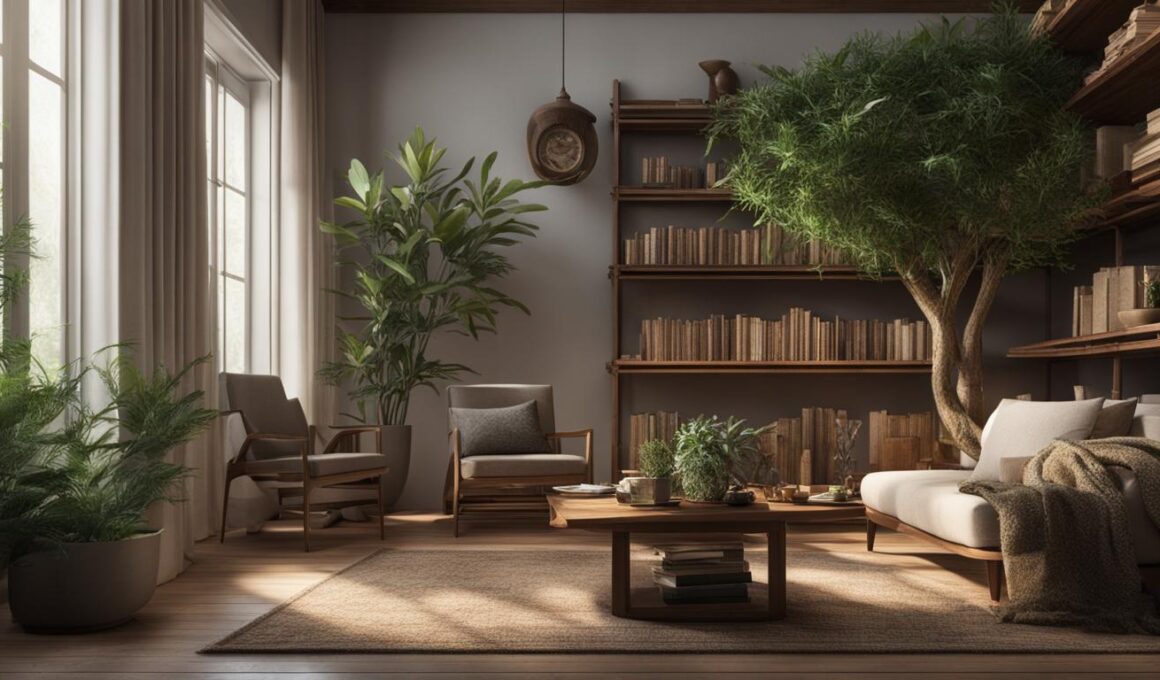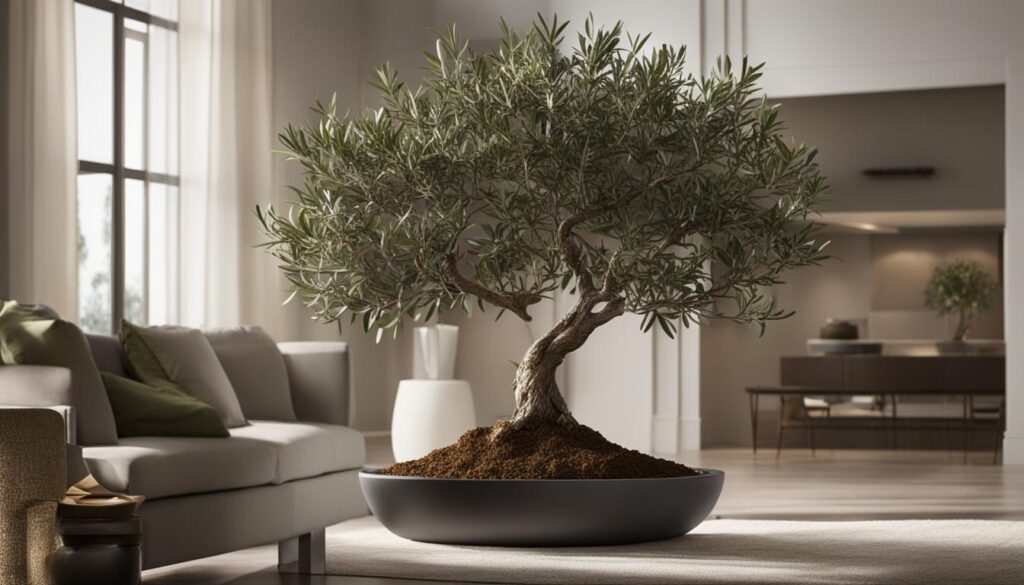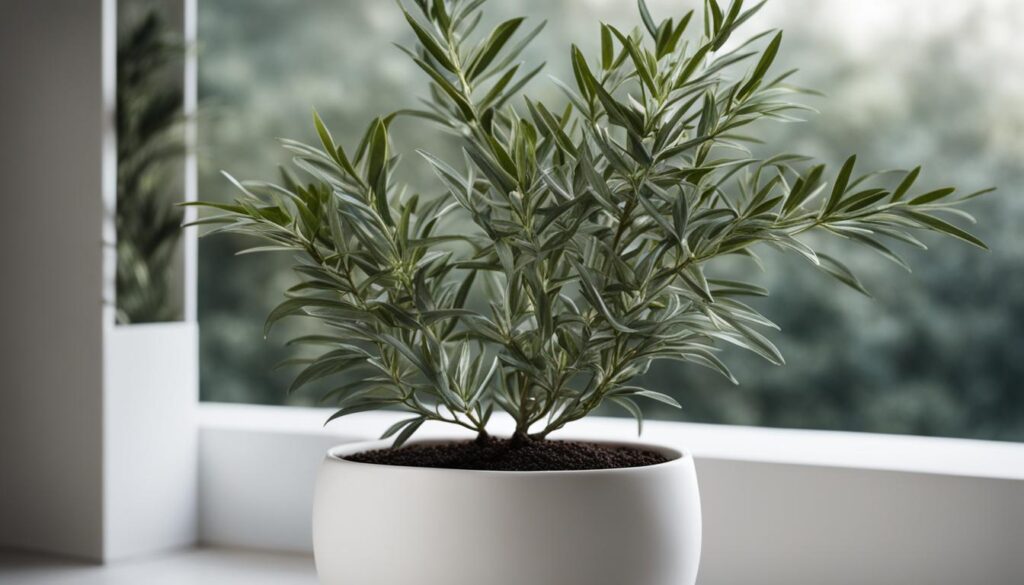If you’re looking to add a touch of elegance and a hint of the Mediterranean to your home decor, indoor plants that resemble olive trees are the perfect choice. Not only do these plants bring a natural and refreshing vibe to any indoor space, but they also improve air quality, making your home a healthier place to live.
Post Summary
- Indoor plants that resemble olive trees are a great way to add a touch of the Mediterranean to your home decor.
- These plants not only enhance the aesthetic appeal of your indoor space but also improve air quality.
- Ficus Microcarpa ‘Ginseng’ is a popular indoor tree that closely resembles olive trees and has air-purifying properties.
- The Arbequina Olive Tree can bring a sense of elegance and the Mediterranean aesthetic to your indoor space.
- The False Olive Plant, also known as Buddleja saligna, is a tropical evergreen that can be a stunning focal point in any indoor garden.
Ficus Microcarpa ‘Ginseng’: A Resemblance to Olive Trees
When it comes to indoor plants that closely resemble olive trees, the Ficus Microcarpa ‘Ginseng’ is a standout choice. With its thick, bulbous trunk and shiny, dark green leaves, this tree showcases a striking resemblance to its Mediterranean counterpart. While it can reach towering heights of up to 40 feet when grown outdoors, it can also thrive as an indoor tree, making it a versatile option for any home or office.
One of the key advantages of the Ficus Microcarpa ‘Ginseng’ is its adaptability to different lighting conditions. Whether your indoor space receives ample sunlight or is more shaded, this plant can adjust and flourish accordingly. Additionally, it is known for its air-purifying qualities, effectively removing toxins and improving the overall air quality of your living or working environment.
When caring for the Ficus Microcarpa ‘Ginseng’, it is important to provide it with proper watering and maintenance. While it doesn’t require excessive watering, it is essential to keep the soil consistently moist and to mist the leaves occasionally to mimic its natural habitat. Regular pruning can also help maintain its aesthetic appeal and control its growth.
Arbequina Olive Tree Care Guide
| Care Aspect | Details |
|---|---|
| Lighting | Bright, indirect light or direct sunlight for at least 6 hours a day. |
| Watering | Keep the soil consistently moist, but not wet. Water when the top inch of soil feels dry. |
| Temperature | Optimal temperature range is between 60-80°F (15-27°C). |
| Humidity | Can tolerate a wide range of humidity levels, but prefers higher humidity. |
| Soil | Well-draining soil mix with organic matter. |
| Fertilizer | Feed with a balanced liquid fertilizer every 2-4 weeks during the growing season. |
False Olive Plant: A Showstopper in Any Indoor Garden
If you’re looking to add a touch of exotic beauty to your indoor garden, the False Olive Plant, also known as Buddleja saligna, is an excellent choice. This tropical evergreen plant features glossy, dark green leaves and a bushy, branching habit that closely resembles the shape of an olive tree. With its striking appearance and easy maintenance, the False Olive Plant is sure to be a showstopper in any indoor space.
The False Olive Plant is native to South Africa and is well-suited to indoor cultivation. It thrives in bright, indirect light and prefers moderate humidity levels. This makes it a perfect addition to living rooms, bedrooms, or offices with ample natural light. Plus, its tropical origins mean it can tolerate slightly warmer temperatures, making it ideal for indoor environments.
One of the standout features of the False Olive Plant is its ability to attract butterflies with its fragrant flowers. The plant produces small clusters of white or cream-colored blooms that release a delightful scent, creating a serene and inviting atmosphere in your indoor garden. Not only will you enjoy the plant’s visual beauty, but you’ll also be treated to the sight of beautiful butterflies fluttering around.
Comparison of False Olive Plant and Olive Tree
| Feature | False Olive Plant | Olive Tree |
|---|---|---|
| Native Region | South Africa | Mediterranean |
| Height | Up to 30 feet indoors | Up to 40 feet outdoors |
| Foliage | Glossy, dark green leaves | Gray-green leaves |
| Flowers | Clusters of white or cream blooms | Small, white flowers |
| Fragrance | Delightful scent, attracts butterflies | Mild aromatic scent |
As seen in the table above, the False Olive Plant offers several advantages over its olive tree counterpart. It is more compact in size, making it suitable for indoor cultivation, and its fragrant flowers add an extra element of beauty to your space. Additionally, the glossy leaves of the False Olive Plant provide a lush, tropical look that can instantly elevate the aesthetics of any indoor garden.
With its striking appearance, easy maintenance, and unique features, the False Olive Plant is a fantastic choice for anyone seeking a showstopper in their indoor garden. Whether you’re a seasoned plant enthusiast or a beginner looking to add some greenery to your space, the False Olive Plant is sure to impress with its beauty and charm.
Conclusion
While an actual olive tree may not be suitable for indoor cultivation, there are several indoor plants that closely resemble olive trees and can bring the beauty and elegance of the Mediterranean to your home. These olive tree alternatives allow you to create your own green oasis, adding a touch of natural beauty to your indoor space.
One option is the Ficus Microcarpa ‘Ginseng’, which features a thick, bulbous trunk and shiny, dark green leaves similar to those of olive trees. This versatile plant can thrive in different lighting conditions and has the added benefit of purifying the air in your home.
Another choice is the Arbequina Olive Tree. Although typically an outdoor plant, it can flourish indoors with proper care. Its gnarled trunks and small, gray-green leaves closely resemble those of olive trees, adding a touch of elegance and the Mediterranean aesthetic to your indoor garden.
For a show-stopping addition to your indoor garden, consider the False Olive Plant. With its glossy, dark green leaves and bushy, branching habit, this tropical evergreen closely mirrors the shape of an olive tree. It can grow tall and become a stunning focal point in your indoor space.
With these indoor plant alternatives, you can transform your home into a green oasis. The beauty and elegance of olive trees can still be enjoyed indoors through these plants that mimic their appearance. So go ahead and bring a touch of the Mediterranean to your home with these olive tree lookalikes.
FAQ
Can olive trees be grown indoors?
While growing an olive tree indoors may not be practical for most people, there are several indoor plants that resemble olive trees and can bring a touch of the Mediterranean to any indoor space.
What is Ficus Microcarpa ‘Ginseng’?
Ficus Microcarpa ‘Ginseng’ is a popular indoor tree that features a thick, bulbous trunk and shiny, dark green leaves similar to those of olive trees. It can reach heights of up to 40 feet outdoors but can also thrive as an indoor tree. This plant is known for its adaptability to various lighting conditions and its ability to purify the air, making it a great addition to any home or office.
Can an Arbequina Olive Tree be grown indoors?
While typically an outdoor plant, the Arbequina Olive Tree can flourish indoors with proper care. It features gnarled trunks and small, gray-green leaves that closely resemble olive trees. This tree requires bright light and regular watering, but it can be a beautiful and unique addition to any indoor space, bringing a touch of elegance and the Mediterranean aesthetic.
What is the False Olive Plant?
The False Olive Plant, also known as Buddleja saligna, is a tropical evergreen that features glossy, dark green leaves and a bushy, branching habit resembling the shape of an olive tree. It can grow up to 30 feet tall if given proper growing conditions and can be a stunning focal point in any indoor garden.
Can I create a green oasis at home with olive tree alternatives?
While an actual olive tree may not be suitable for indoor cultivation, there are several indoor plants that closely resemble olive trees and can bring the beauty and elegance of the Mediterranean to your home. Whether you choose Ficus Microcarpa ‘Ginseng’, Arbequina Olive Tree, False Olive Plant, or any other plant that mimics the look of olive trees, you can cultivate your own green oasis at home with these indoor plant alternatives.
What Indoor Plants Resemble Olive Trees and Can Be Grown Indoors?
If you’re interested in growing olive trees indoors complete, consider trying a houseplant called Arbequina olive tree. These small trees resemble olive trees and can thrive indoors with proper care. Another option is the Koroneiki olive tree, which also does well in indoor settings.










